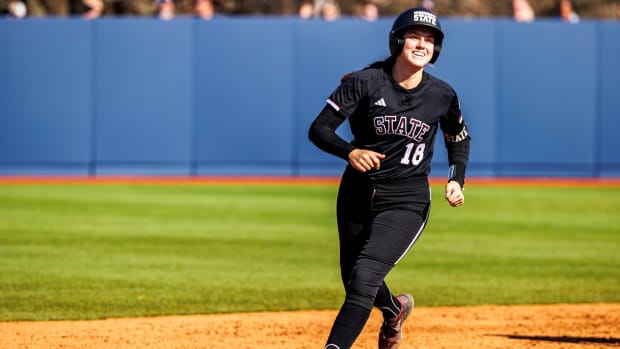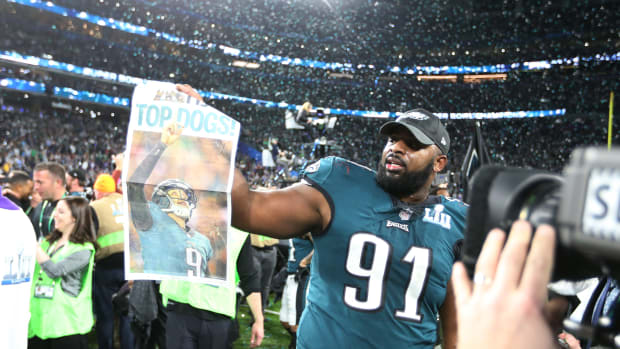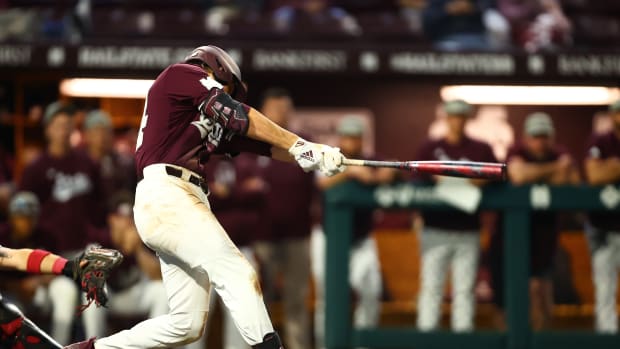More Than One Way to Achieve 'Balance': Receivers in the Air Raid Offense
Balance within an offense in the modern era is typically pitched as passing and running the ball about an equal amount.
But looking at all "balanced" offenses that do that, there's something that suggests more imbalance than anything else.
Instead of looking at the percentage of times teams run and pass the ball, an important thing to consider is how many players are touching the ball and how often they are doing so.
"There is nothing balanced about running it 50 percent of the time and throwing it 50 percent of the time if you are only utilizing two or three offensive skill positions and only attacking part of the field," Mike Leach wrote in "Swing Your Sword." "A good offense has the ability to attack as much of the field as possible with as many people as possible. You want to put as much pressure on the defense as you can while utilizing all of the space and personnel you have."
Here's a quick overview of what each of the offensive positions (outside of the quarterback and the offensive linemen) do, what you'd typically be looking for with a player at each of these spots and where players were listed in Mississippi State's first depth chart of the season:
X: Outside receiver - Typically is the fastest receiver.
Malik Heath
Lideatrick "Tulu" Griffin"
Y: Inside receiver - Stays on the right. Hal Mumme describes the Y as a guy who "has a passion for catching the ball and doesn't mind getting hit when he catches it." Works the middle of the field a lot.
Austin Williams
Jaden Walley
Christian Ford
Z: Outside receiver - Moves around a good bit, just as the H does. Plays on both the left side and the right side.
Makai Polk
Caleb Ducking
F: Featured back - running back - Needs to be able to block, catch the ball out of the backfield and (obviously) run. Can be a big power back or a small scat back. This offense demands and produces versatility from players at this position, which carries over well to the NFL where all-purpose backs are heavily in demand.
Jo'quavious "Woody" Marks
Dillon Johnson
H: Inside receiver/tight end - Can line up in multiple places, versatile. Wes Welker is among the most well-known to have played as an H.
Jamire Calvin
Rufus Harvey
Deciding where to put players:
Evaluating players at any position is difficult to get right when taking the first swing at it. There's a process that goes into deciding whether to put a player on the inside or outside, and just because he starts at one spot doesn't mean he won't eventually be moved to another one.
"We try to slot them maybe initially by body type, and as we get to know them and talk to them, look at whatever film they might have, we kind of go from there," inside receivers coach Dave Nichol said. "We can kind of figure it out after a few practices where we think we'd like them to be."
Nichol describes the formula to deciding where a receiver plays as need plus size and ability.
"Last year with injuries and depth issues it was just kind of an interesting year, so we had to move some guys," he said. "But, that's the other thing -- a lot of times it can come down to need. If we have three awesome Y's and not a great X, then we've got to put somebody at X."
There's a bit of trial and error that goes into it.
"It's interesting, because when we first got here we just kind of went through the roster and tried to shuffle them out and figure it out. There are different characteristics for every position," Spurrier said.
Bigger guys will typically play on the outside. Most of the inside guys are a little shorter. But I've coached guys on the outside that are 5'9, 5'10 who have been really good players. Inside guys are a little quicker. Outside guys tend to be bigger, hopefully, they're all fast. Inside guys have to be able to block more than the outside guys do. We (outside receivers) have to block a little bit but inside guys have to. And that's tough, too, because sometimes your smaller, quicker guy is not necessarily your best blocker."
It should also be noted that some receivers have the ability to play in more than just one spot. Austin Williams, who has drawn high praise from the coaching staff, is one of those guys.
He's played at both H and Y in the Air Raid at MSU, and there's not exactly an easy thing to do, according to Nichol.
"The top trait has to be that he's highly intelligent. It's just not easy to play both in our system," Nichol said. "So, just understanding and grasping the concepts can take a while. Austin picked it up pretty quickly. It was kind of natural to get him going... I always like to double-teach, as we call it. Have one, maybe two guys that can do both. Anything can happen during the season."
Eight receivers in every game:
An "OR" between two players, depending on scheme and position, can indicate that one player starts the game and plays the whole thing while the other one sees no action. That's not at all the case here -- and it's one of the easiest and most surface-level aspects of this offense to understand.
The Bulldogs play eight receivers in every game. It contributes to the sense of balance Leach describes and helps ensure that all players are ready to go at any given time.
"We play eight receivers in every game," Bulldogs outside receivers coach Steve Spurrier Jr. said. "What's neat about it and what I like is that nobody is ever nervous about playing. They know they're going to play. They all get a lot of experience. As far as the "Ifs" "ORs" I have two guys at my positions, and the guy that grades better in the game will start the next one. We want to get a bunch of guys ready to play."
There's a method to all of that.
"Leach wants to distribute the ball evenly to each position, to each running back, to each area of the field," Spurrier said. At halftime, we actually go over that. How many balls have we thrown to H? How many has he caught? How many have we thrown here? We go through all of that pretty specifically, so there's some science behind how we try to do that."
The cream still rises to the top:
In a lot of offenses, especially pro-style, there is oftentimes a prominent No. 1 wideout who accounts for the vast majority of the team's receiving yards. While you don't see that type of dominance from one guy on Air Raid teams, players still reap what they sow and that will show up in targets, receptions and total yards.
"Some things aren't always just positionally, it's also a have you been practicing hard, are you taking care of your business, so all of those things go into account," Nichol said.
"I'll say this, and I tell my guys this -- when Michael Crabtree was at Texas Tech, the Z receiver got the most balls. When I had (Rob) Gronkowski at Arizona, he got the most balls. When Wes Welker was an H, the H got the most balls. So at the end of the day, the cream does rise to the top, but yes, we do like distribution. If you're open and reliable, you're going to get the ball more regardless of position."
What does playing in the Air Raid teach/bring out in receivers?
There's nothing especially complicated about the Air Raid -- it's a repetition-based offense that's focused on execution.
"If I can describe what we do, what I always go back to is that there's creativity within the simplicity," Nichol said. "Our plays are simple, but some of the things within it are sometimes unique. You kind of talk through plays as they're happening on tape and they start to get a feel... a lot of our receivers when we got here, as we researched, hadn't played a ton of our kind of ball in high school, which is totally fine. In this offense, it's finding space, knowing where to sit (in zones), just kind of that general stuff."
Receivers stand to learn a lot and gain a lot from playing in this offense, despite what the perception has been in the past.
"I think learning defenses more, just like zone coverage, man coverage, here's how people play you and a lot of people would say it's the exact opposite," Nichol said. "We don't talk a ton about coverages, but when we get into our routes, we're seeing what the defense is doing and we like to think to that we run every route that everybody else does, which now, this offense is in the NFL and now we don't have to recruit against people who say stuff like that."
With my guys and Steve's guys, it's a toughness issue with screens, people just think they're pretty basketball players, but we run a lot of screens, we've got to block and a lot of people don't make their guys, within the offense they're running, do that."




